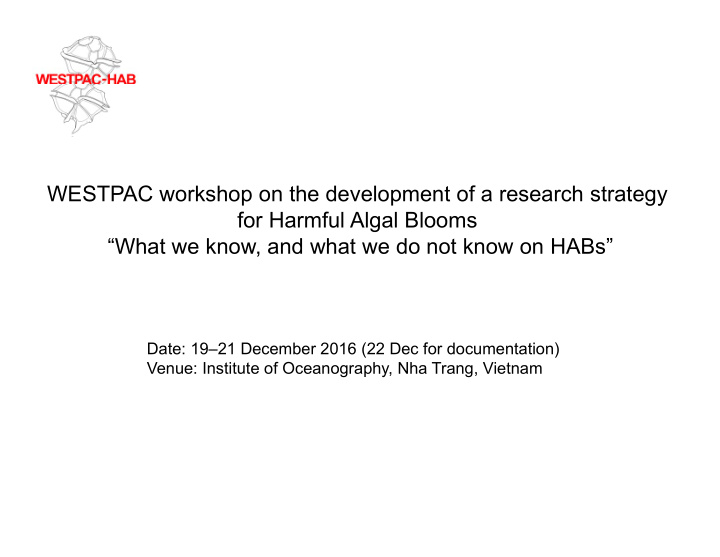



WESTPAC workshop on the development of a research strategy for Harmful Algal Blooms “What we know, and what we do not know on HABs” Date: 19–21 December 2016 (22 Dec for documentation) Venue: Institute of Oceanography, Nha Trang, Vietnam
Background Harmful algal blooms, or HABs, occur when cells of microalgae—simple unicellular phytoplankton that live in the sea and freshwater—grow and form high biomass while producing toxic substance or causing harmful effects on people, fish, shellfish, marine mammals, and birds. Harmful algal blooms (HABs) have direct impacts to human health and negative influences on human well-being, mainly through their consequences to coastal ecosystem services (fisheries, tourism and recreation) and other marine organisms and environments. HABs are natural phenomena, but these events can be favored by anthropogenic pressures in coastal areas. To minimize the negative impacts of HABs in the Western Pacific and its adjacent regions, IOC Sub-Commission for the Western Pacific (WESTPAC) has long been fostering research collaborations, building scientific capacity of individuals, institutions and countries on HABs, in order to assist its Member States to understand their causes, predict their occurrences and mitigate their effects. Given the ever-increasing algal blooms over the recent years in the region, and the scientific uncertainties existing in identifying the causes of some of these events, it is imperative to examine our present knowledge, identify gaps and challenges, strengthen scientific collaborations and finally develop a regional research strategy for HAB studies in the future with a view to better assisting our member states in reducing economic loss and risks to human health in the region.
Recent HAB issues in the region Ha Tinh, Vietnam, April 2016 (https://news.mongabay.com/2016/05/taiwanese-chemical- Johor Strait, Malaysia-Singapore spill-thought-cause-mass-fish-die-off-vietnam/) Feb 2014 and Feb 2015 (Lim et al. 2015, Harmful Algae) Workshop in Bangkok, Thailand, Lampung Bay, Indonesia May 2016 Oct 2012- (Thoha et al. 2016, Harmful Algae News)
Aims In web announcement; (i) review current knowledge on HAB science, techniques and technologies in the region; (ii) identify scientific problems/questions/gaps to address; and (iii) develop a research strategy for future HAB studies. In “Guideline of Presentations” (updated); (i) Share information of recent HAB events to observe any trend of occurrence and emerging problem; (ii) Review current knowledge on HAB science, techniques and technologies; (iii) Identify scientific problems/questions/gaps in the region to address HAB problems; (iv) Develop a research strategy for future HAB studies and management, (v) Publish a report to announce current and future HAB science status of the region.
Program [Day 1] 19 December (Monday) Part 1. Recent HAB occurrence and emerging necessary HAB topics Part 2. Biology and ecophysiology of toxin producing species (Chair: Sandric) [Day 2] 20 December (Tuesday) Part 3. Toxin and toxic species (Chair: M Kodama) Part 4. Biology of harmful red tide species (Chair: PT Lim) [Day 3] 21 December (Wednesday) Part 5. Killing mechanisms of marine organisms (Chair: Y Fukuyo) Part 6. Socio-economics and management (Chair: Gires Usup) [Additional Day] 22 December (Thursday) Wrap-up of the discussion and Report “Scientific research strategy on HAB” preparation (Chair: RV Azanza and CP Leaw) - Part 1: Exchange and sharing current HAB issues in the region - Part 2-6: Sharing and compiling current scientific information “what we know, and what we do not know” - Report: “Scientific research strategy on HAB”
Presentations Reporting recent HAB events (Part 1) - Information of recent and new HAB information is welcome! - Provide information, e.g., type of HAB, causative species, trouble, difficulty to solve the problem, scientific subject, etc. - Expectation to WESTPAC-HAB and TMO projects Presentation on HAB scientific topics (Part 2-6) - Explanation of current status of each scientific topic - Existing knowledge on the topics in the region - Lacking knowledge/skills on the topics in the region - List of topics, preferably with priority, expected to be addressed in near future During discussion, all participants provide additional information especially for “list of HAB science topics expected to be addressed in near future” Documentation - Please prepare summarized contents including items of the scientific topics we should address in future (what we do not know) by word file - Please prepare the word file before presentation and pass it to Drs Rhodora Azanza and Chui Pin Leaw, to facilitate documentation.
WESTPAC-HAB IOC/WESTPAC-HAB project is, - Supported mainly by Japan Funds-in-Trust (JFiT). - We can have one/two strategic or training workshops in every one/two years. - WESTPAC-HAB project is research project but available function is limited, i.e., information exchange, networking, capacity building, etc. (research?). - Research activities on HAB is really depending on personal efforts (budgetary or manpower). - The outcome of the workshop (word file) will be distributed during WESTPAC Scientific Conference, Qingdao, China, in April 2017! (At present 72 papers were submitted to the scientific session of “C15 Harmful Algal Blooms”, and we also have a side workshop) - Outcome of this workshop will be utilized by HAB researchers in this region. - Have a fruitful discussion!
WESTPAC Supports Announcement and registration via webpage Travel arrangement by WESTPAC Office (Wenxi and Nok) Local arrangements by IO (Dao)
Recommend
More recommend